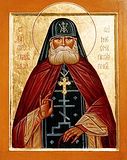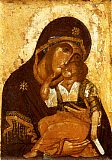

| Previous day | Next day |
| Old Style
March 19
|
Monday |
New Style
April 1
|
|
4th Week of Great Lent.
Tone 3.
Great Lent. |
Monastic rule: xerophagy (bread, uncooked fruits and vegetables).
|
![]() Martyrs Chrysanthus and Daria, and those with them at Rome: Claudius the Tribune, his wife Hilaria, their sons Jason and Maurus, the priest Diodorus, and the deacon Marianus (283).
Martyrs Chrysanthus and Daria, and those with them at Rome: Claudius the Tribune, his wife Hilaria, their sons Jason and Maurus, the priest Diodorus, and the deacon Marianus (283). ![]() St. Sophia of Slutsk and Minsk (1612).
St. Sophia of Slutsk and Minsk (1612).
Martyr Pancharius, at Nicomedia (ca. 302). St. Bassa, nun, of Pskov Caves (ca. 1473). St. Innocent, founder of Komel Monastery (Vologda) (1511-1522).
Smolensk “Umileniye” (“Tender Feeling”) Icon of the Most Holy Theotokos (1103).
Righteous Maria, wife of Vsevelod III (1206). New Martyr Demetrius, at Constantinople (1564). New Martyr Nicholas Karamanos of Smyrna (1657). St. Symeon (Popovic), archimandrite, of Dajbabe, Montenegro (1941).
Thoughts for Each Day of the Year
According to the Daily Church Readings from the Word of God
By St. Theophan the Recluse

Monday (the fourth week of Lent).
The Apostle Paul says that the Israelites, crossing the sea, were baptized in it (I Cor. 10:2).[1] Such a baptism served for them as a division between Egypt and themselves. Peter the Apostle adds: The like figure whereunto even baptism doth also now save us (I Pet. 3:21). Our baptism saves us and serves as a dividing wall between the dark, satanic realm of sin and the world, and the brightness of life in Christ. One who is baptized cuts himself off from all earthly hopes and supports, and lives in this age as if in a desert, not tied to anything. His heart is not on the earth, it is totally in that age. All that is here touches him in passing, so that having a wife he is as though he has none; buying, he is as though possessing nothing. In general, he uses the world, as though he uses it not (cf. I Cor. 7:30).
[1]The
Slavonic for I Pet. 3:21 reads: So in like manner
baptism doth also now save us.
Articles
 Martyr Pancharius at NicomediaThe Holy Martyr Pancharius was a friend of the emperor Diocletian. He abandoned Christianity and became a pagan. |
 Icon of the Mother of God of Smolensk the “Sweet-Kissing”The Smolensk “Tenderness” Icon of the Mother of God manifested itself in the year 1103 at Smolensk. |




